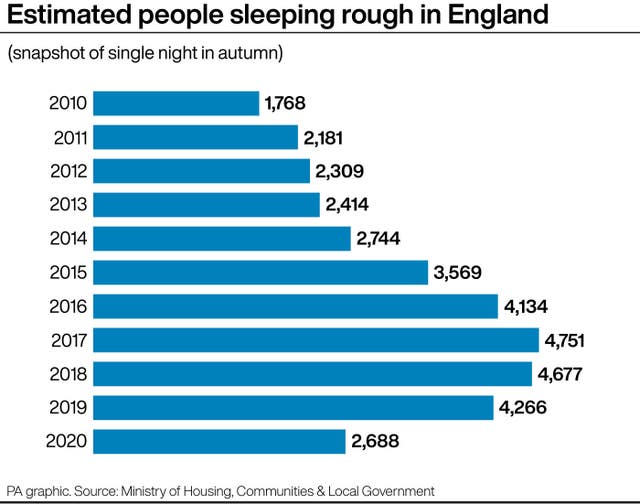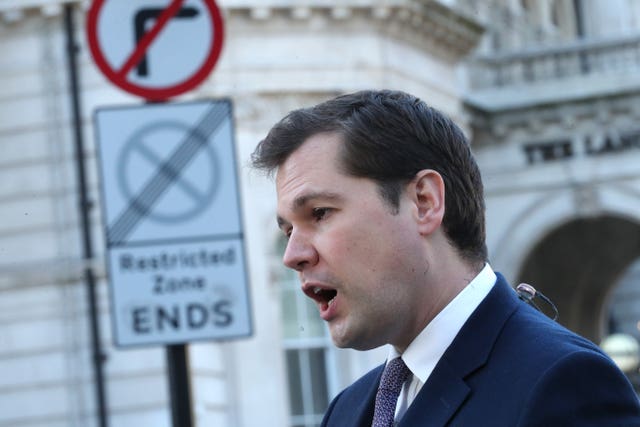The number of people estimated to be sleeping rough on a single night in autumn fell by more than a third in a year, figures show.
There were 2,688 people estimated to be sleeping rough on any single night in England during October and November, the Ministry of Housing, Communities and Local Government (MHCLG) said.
This is the third consecutive annual fall, and a drop of 37% compared with 2019.
But it remains 52% higher than the number estimated in 2010, when the “snapshot” approach was first introduced.

Local authorities said the fall was due to the Government’s Everyone In scheme, with councils instructed to rapidly rehouse thousands of rough sleepers at the start of the Covid-19 pandemic, and the Rough Sleeping Initiative which launched in 2018.
MHCLG said other factors to be considered when comparing the annual snapshots were the weather, movement across local authority boundaries, the date and time of the snapshot and availability of night shelters.
The snapshot coincided with a national lockdown throughout November and tier restrictions in October.
About 44% of people sleeping rough on a single night in autumn were in London and the South East, areas which saw the largest annual decrease.
The North East had the lowest number of estimated rough sleepers, and was the only region that showed a small annual rise.
Similar to previous years, most rough sleepers were believed to be male, over 26 and from the UK.
Housing Secretary Robert Jenrick said he was “heartened” by the fall and said the priority is to “maintain this momentum”, promising a “marriage of health and housing”.

He said more recent data, while not official, shows the total number of people estimated as sleeping rough fell further to 1,461 at the end of January.
He said: “Today’s figures demonstrate that by working hand in hand with councils, charities and faith groups, the Government has made huge progress towards ending rough sleeping and responded to the danger posed by the pandemic in an internationally recognised way.”
The Government is working to eliminate rough sleeping by the end of this parliament, with £750 million being spent over the next year to tackle homelessness and rough sleeping.
Of this, £6.4 million will help voluntary organisations provide accommodation and referral services.
Mr Jenrick told MPs: “We will never live in a country, sadly, where there is not a single person sleeping rough on the streets. But the litmus test for a civilised society must be that nobody has the need to, and that everybody is offered support swiftly – not so much no second night out, but no first night out.”
Some 205 councils saw falls in their rough sleeper estimates from 2019, 78 saw rises, and 31 saw no change.
Thirty areas recorded no rough sleepers.
The areas with the highest numbers of people estimated to be sleeping rough were Westminster, Manchester and Bristol.
The largest increase was in Tower Hamlets, east London, with 40 people estimated to be sleeping rough, compared with 17 last year.
Areas which saw rises said these were largely due to the pandemic, with people losing their jobs, being unable to pay rent or accommodation, illegal evictions, relationship breakdowns, sofa surfers being asked to leave and reduced winter shelter provision.
Some councils said the increase could have been due to increased outreach services leading to a more accurate view of rough sleepers in their area.
Polly Neate, chief executive of Shelter, said “every week” its frontline staff were witnessing new cases of homeless people being refused help.
She said: “Whether someone is offered a safe bed for the night instead of a cold pavement should not be up for debate. The pandemic isn’t over and we must continue to keep people safe.
“The Government needs to ensure its hard work is not undone by giving councils explicit guidance to provide everyone with emergency accommodation and support.”
Government figures published today reveal the largest decrease in the estimated number of people rough sleeping since 2010
📈But this is still 52% higher than when the snapshot approach was introduced a decade ago 📈
⬇️Read more in our latest blog ⬇️https://t.co/5Xa54wUNan
— Homeless Link (@HomelessLink) February 25, 2021
Rick Henderson, chief executive of Homeless Link, said the reduction in the estimate was “something to celebrate”.
He added: “While it is unfortunate that it took exceptional circumstances – a global pandemic – to prompt the focused action and investment required, it proves what can be accomplished with joint effort across Government and between sectors.
“However, we cannot ignore the unacceptable fact that thousands of people are still forced to sleep on our streets.
“People with no recourse to public funds, and those newly arriving on the streets having lost jobs and homes during the pandemic, continue to be overlooked in the current homelessness response, to their huge detriment.
“Prevention will be key going forward, but the end of the eviction ban in March, and the risk that the Universal Credit uplift will be removed, threaten this.”
A spokesman for the mayor of London praised the “world-leading work” done to get people off the streets during the pandemic, but said Government support had since dwindled.
He said: “Our outreach teams warn us that there is still a steady flow of new rough sleepers to the streets.
“If the Government is serious about ending homelessness we need bold action in next week’s Budget to tackle the root causes of rough sleeping and support those most at risk of homelessness.”
Thangam Debbonaire, Labour’s shadow housing secretary, said: “There is a real risk that gains made last year will be lost.
“We came into this crisis with twice as many rough sleepers as in 2010. Almost 1,000 people died while homeless in 2020. We cannot return to business as usual.”




Comments: Our rules
We want our comments to be a lively and valuable part of our community - a place where readers can debate and engage with the most important local issues. The ability to comment on our stories is a privilege, not a right, however, and that privilege may be withdrawn if it is abused or misused.
Please report any comments that break our rules.
Read the rules here